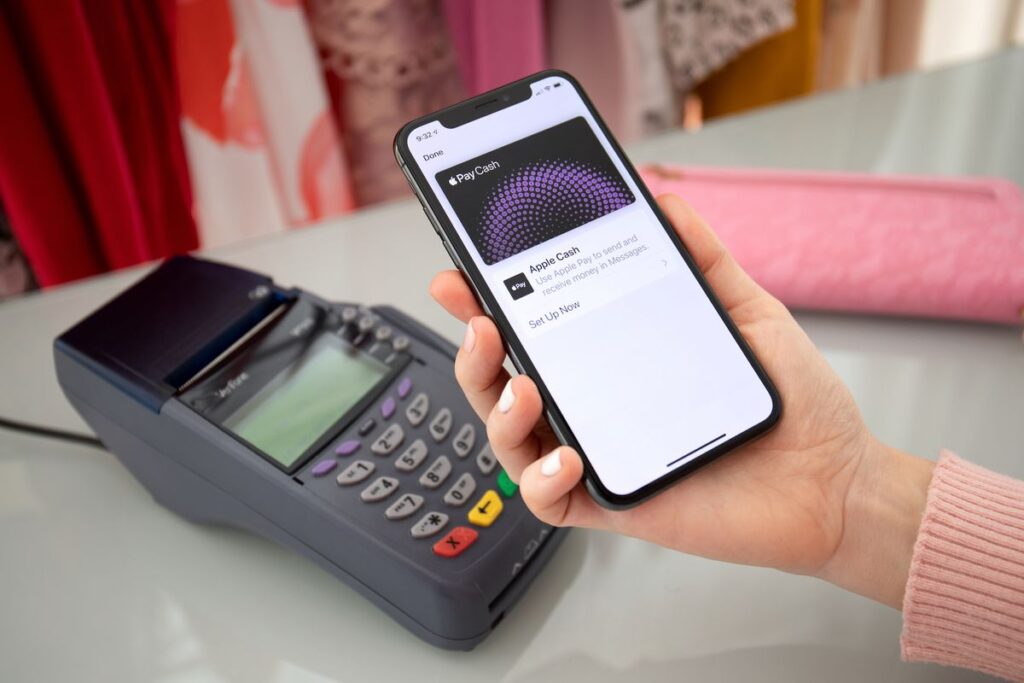Apple Pay is a digital wallet and mobile payment service created by Apple Inc. It uses near-field communication (NFC) technology to facilitate secure, contactless transactions.
The service integrates with Apple devices, allowing users to store and use credit or debit card information without needing the physical card. Authentication is done through Face ID, Touch ID, or a device passcode, ensuring secure and convenient payments.
How do I use Apple Pay?
To use Apple Pay, follow these steps:
1. Add a Card: Open the Wallet app on your Apple device and tap the “+” sign to add a credit or debit card. Follow the prompts to enter card details.
2. Set Up: Verify your card through your bank or card issuer if needed.
3. In Stores: Hold your device near the contactless reader with your finger on Touch ID, use Face ID, or enter your passcode.
4. In Apps or Online: Select Apple Pay as the payment method at checkout. Confirm the payment using Face ID, Touch ID, or your passcode.
What are the main benefits of using Apple Pay?
Apple Pay offers several key benefits that make it an attractive payment option. Here are 6 of them:
- Security: Apple Pay enhances security by using a unique device-specific number and transaction code for each purchase. Your actual card numbers are never stored on your device or Apple’s servers, nor are they shared with merchants. This significantly reduces the risk of card information being stolen.
- Convenience: Apple Pay allows for quick and easy payments in stores, within apps, and on websites. You no longer need to carry physical cards or enter payment information manually. Simply hold your device near the contactless reader and use Face ID, Touch ID, or your passcode to confirm the payment.
- Privacy: Apple Pay is designed to protect your personal information. Apple doesn’t track your purchases, ensuring that your shopping habits remain private. Only you and the merchant know what you bought.
- Ease of Use: Setting up and using Apple Pay is straightforward. Add your credit or debit card to the Wallet app, and you’re ready to make payments with just a tap or a glance. The integration with Apple devices means you can use it on iPhones, Apple Watches, iPads, and Macs.
- Widespread Acceptance: Apple Pay is accepted at a growing number of retailers, restaurants, and online stores around the world. Major credit and debit cards from various banks are supported, making it versatile and accessible.
- Rewards and Benefits: Using Apple Pay doesn’t mean you miss out on rewards or benefits. You still earn points, cash back, and other rewards from your bank or card issuer when you use Apple Pay.
Apple Pay provides a secure, private, and convenient way to make transactions without the need for physical cards. It is easy to use, widely accepted, and supports earning rewards, making it a practical choice for modern payment needs.
How secure is Apple Pay?
Apple Pay is a very secure payment option.
Each transaction uses a one-time transaction code, so your card number remains private. Apple Pay assigns a unique device account number for each card, stored securely on your device’s Secure Element chip.
You can authorize payments only by authentication through Face ID, Touch ID, or a passcode.
Card numbers are never stored on your device or Apple servers, reducing theft risk. Apple Pay also keeps your purchase history private, enhancing security and privacy.
These features protect your payment information and ensure secure transactions.
Which banks support Apple Pay?
Many banks support Apple Pay, including major institutions like Bank of America, Chase, Citibank, Wells Fargo, and Capital One. Numerous regional banks, credit unions, and international banks are compatible with Apple Pay.
If you want to confirm that your bank supports Apple Pay, check Apple’s website or contact your bank directly.
Can I check my card balance?
No, Apple Pay does not allow you to check your card balance directly. To view your balance, you need to use your bank’s app, website, or contact them directly. Apple Pay focuses on making secure payments rather than providing banking features like balance inquiries.
Does it cost extra to use Apple Pay?
No, using Apple Pay does not incur any additional costs. Apple does not charge fees for transactions made with Apple Pay. Standard fees and interest rates from your bank or credit card provider still apply.
How can my business accept Apple Pay?
To accept Apple Pay at your business, follow these steps:
- Upgrade Your Payment Terminal: Make sure your payment terminal supports near-field communication (NFC) technology. Most modern terminals are equipped with this feature.
- Contact Your Payment Processor: Reach out to your payment processor to confirm compatibility and get assistance with setup. They can guide you through the process of enabling Apple Pay on your terminal.
- Display Apple Pay Logo: Inform customers that you accept Apple Pay by displaying the logo at your point of sale and on your website. This encourages them to use it as a payment option.
- Train Your Staff: Make sure your employees know how to process Apple Pay transactions and assist customers if needed.
What’s the difference between Apple Cash and Apple Pay?
Apple Pay and Apple Cash serve different purposes within the Apple ecosystem.
Apple Pay is a mobile payment service that allows users to make secure payments in stores, online, and within apps using their Apple devices. It functions by storing your credit and debit card information digitally, enabling contactless and easy transactions without needing physical cards.
Apple Cash is a digital card within Apple Wallet that allows users to send and receive money through iMessage. The funds received are stored on the Apple Cash card and can be used for purchases through Apple Pay, transferred to a bank account, or kept for future use. Apple Cash also facilitates person-to-person payments, making it convenient for splitting bills or sending money to friends and family.
In summary, Apple Pay is for making payments using stored card information, while Apple Cash is for sending, receiving, and storing money digitally within the Apple Wallet.
Is Apple Pay the same as Apple Wallet?
Apple Pay and Apple Wallet are related but serve distinct functions within Apple’s ecosystem.
Apple Wallet is an app that stores various items digitally, such as credit and debit cards, boarding passes, tickets, loyalty cards, and more. It acts as a virtual wallet, keeping all your important information and passes in one place on your Apple device.
Apple Pay is a payment service integrated within Apple Wallet. It allows you to make secure, contactless payments using the credit and debit cards stored in Apple Wallet. Essentially, Apple Pay is the feature that enables payments, while Apple Wallet is the app that stores and organizes your cards and other items.
So, Apple Wallet is the app for storing cards and passes, while Apple Pay is the feature for making payments using those stored cards.
From now on you can use Apple Pay as a payment method on all Finli Pay-by Links and Digital Invoices. This new option joins our existing payment methods, including Credit Cards and ACH Payments, giving you more flexibility and convenience than ever before.




